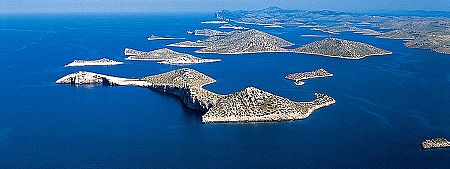Murter Kornati
Due to its geostrategic position, proximity to the highway and the two airports in Zadar and Split, the island of Murter is an ideal starting point if you want to visit Kornati National Park, the densest island archipelago in the entire Mediterranean, which also makes Murter an ideal choice for boat rental.
Murter

Murter is the largest settlement on the island of the same name, located between Zadar (70 km) and Šibenik (35 km). It is connected to the mainland by a short bridge in the small town of Tisno.
It is an important tourist destination known for its numerous historical sights and beautiful nature, magnificent beaches, and uninhabited islands located in its immediate vicinity. It is surrounded by seven hills: Crnikovac, Gradina, Raduč, Veli vrh, Mali Vršak, Veli Vršak and Vršine. With its 125 m, Raduč is the highest peak on the island. Vršine hill, where one can find the church of St. Roko, is certainly the most visited hill which also has a beautiful lookout with a view of the entire settlement. The same also goes for Gradina hill at which foot the ancient Roman settlement of Colentum is located. The island’s most beautiful beaches - Kosirina, Čigrađa, Slanica, Podrvške - are located on its southern side. However, on the northern side one can still find the beach Luke and the recently renovated ancient beach which is a part of the Colentum archaeological site. Murter is the starting port for the famous Kornati islands. Unexplored paths which lead towards hidden bays found in the shade of pine forests hide untold stories of curious travelers and simply call for exploration.
The Kornati islands

The Kornati islands are an island group unique to the entire Mediterranean. They are comprised of more than 150 islands, islets and rocks with a total land area of 69 km². A part of the Kornati archipelago was declared a national park in 1980 due to its indented coastline, geomorphological features, and diversity of marine life.
The most famous geomorphological phenomenon on the Kornati islands and their main characteristic are the “crowns”, high cliffs facing the open sea. The highest crown is located on Klobučar (82m), followed by the one on Veliki Rašip (62m) and Mana (68m). On the north-eastern slope of the Kornati island, near its peak Metlina, there is an interesting locality - Magazinova škrila - which the locals call the Great Plate (Vela ploča). It is a bare and smooth plate 210 m long and 155 m wide inclined towards the sea at an angle of 40°. Along the northwestern border of the national park, one can find the passageway Mala Proversa where the remains of a Roman villa from the 1st century have been preserved.
Be sure to visit historical sights such as the Tureta fort, which bears witness to the arrival of men in this area as far back as the Illyrian time. Although it is in deteriorated state today, the fort is one of the few preserved ones in the area. At the foot of the Tureta fort, you will find the Church of Our Lady of Tarac, built in the 16th century. The church is the final destination for pilgrims who begin their journey on the first Sunday in the month of July.
One of the reasons why part of the Kornati Islands has been declared a national park is its anthropogenic landscape - karst pastures - created by human activity (by regularly burning grass in order to come up with grazing surfaces). Kornati National Park is an incredible meld of nature and humans, who have been living on the Kornati for several thousand years, which is reflected in the always modest but impressive building structures (stone gates, shepherds’ huts, dry-stone walls, olive orchards, small docks, forts, castles, small churches, salt pans, etc.).
A long distance from the coast, the biological richness of the underwater world, pirate raids, good pastures, turbulent history, barren karst landscape, good protection from bad sea weather... - all these are reasons why the Kornati Islands in the course of human history have always been a hospitable and inhospitable place at the same time. Constantly on the border between peace and unrest, wealth and poverty, the Kornati archipelago has always been and still remains a challenge to various cultures and different interests in this region.
